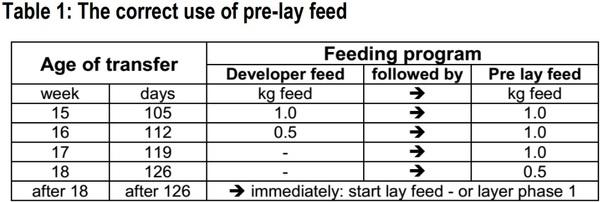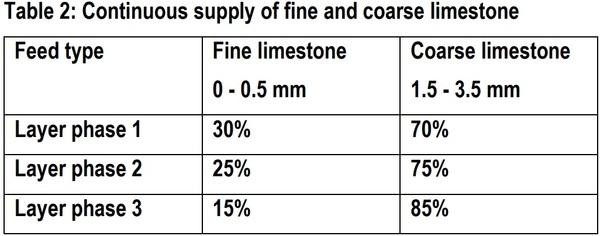Introduction
Modern layer hybrids are a four-line-cross with a long breeding history and show a very high production potential in different housing systems all around the world. This proofs for white egg producing lines and for brown egg producing hens as well. Due to ongoing genetic work the egg industry and farmers realise steadily increasing persistency and longer liability under all housing conditions. The higher performance has been achieved by an increased efficiency too, which means that the daily feed intake has not been increased over the last ten years. In practice this can be shown by a steadily increasing feed conversion ratio. Based on parent stock performance data from the last four years it can already be expected that the performance on commercial level will be further increased. The main increase in laying percentage is based on longer clutch length and improved uniformity of layer flocks. The most popular aim of nowadays’ layer geneticists is the 500 egg hen – in one cycle and without molting. Genomic selection will even speed up the process to achieve this aim. Under good conditions this aim has already been reached in quite a lot of flocks all around the world and sometimes farmers start kind of a competition how long they can extend the lifetime production period of layer flocks. By doing this, they realise that the egg shell quality at the end of the production period again deserves much more attention and support in comparison to a one year production cycle (72 weeks of life). Additionally the so called post-peak-dip shows up as an additional challenge at the beginning of the production period. Both topics – a secured start of production together with reaching peak performance and optimal egg shell quality up to 90 weeks (or more) of age of flocks – are highly related to optimal nutrition of nowadays’ high prolific layer flocks.
Materials and methods
Importance of rearing and pre-lay phase
Optimal layer nutrition for a long liability and a high number of saleable eggs starts directly after hatch. This means to fulfil the nutritional demand for the enormous growth potential during the first half of the rearing period followed by the decreased growth potential and nutritional consequences in the second half of the rearing period. The feeding programme during the first half of the rearing period needs to focus on an optimal supply of digestible amino acids and even minerals to ensure the basic growth of the inner organs, muscles and even the skeleton in this early stage of life. The second half of the rearing phase is determined by a biologically reduced physiological development of the pullet, which offers the chance of training the pullets for an optimal feed intake capacity respectively feed intake behaviour. This aspect is of enormous importance at the following start of the egg production where all nowadays’layer breeds tend to have a daily feed intake being way too low. During the second half of the rearing phase a reduced demand for protein and amino acids is offering the chance to include lower dense raw materials with higher content of crude fibre into the diet formulation. If suitable raw materials are available, it can be recommended to reach at least 5.5 % crude fibre in this feeding phase. At the end of the rearing period, just before the start of producing eggs, the bird moves from pullet phase to layer phase, which means that nearly all metabolic processes change to a high extend. Due to hormonal regulation the development of the medullary bones is initiated and all metabolic processes move to the egg production. Nevertheless at the start of the production layer flocks need to show further weight gain. The development of the medullary bones takes place roughly throughout ten days, needs additional calcium supply and can be called the pre-lay period. This physiologically based transition period should be used to carry out a smooth transition between two highly different types of feed – meaning developer feed and layer feed – and encourages layer nutritionists to use a pre-lay feed during this period. A pre-lay feed is mainly determined by a content of calcium of around 2 – 2.5 %; the other nutrients can/should be similar to a layer feed. The major challenge to implement the idea of a pre-lay feed is more a question of feed logistics and correct use on farm side in comparison to a basic nutritional question. It can be suggested to use pre-lay feed for approximately ten days with a maximum amount of maximal 1 kilo per pullet. The biggest mistakes happening regularly in practice on layer farms are too early use of pre-lay feed or too long time of using pre-lay feed. Both practices will always harm layer flocks and might destroy a good peak performance of layer flocks. The advantages of a professional use of pre-lay feed can be summarised as followed: smooth transition between too highly different feed types, adapting the birds to the high calcium-content of layer feed, maintaining daily feed intake during this period, offering protein and amino acids for those birds being behind the average body weight, increasing uniformity of pullet flocks, avoiding decalcification of hens already being ahead of the average flock and producing eggs. As these benefits show up regularly all around the world and under all production systems, it is highly recommended to implement the pre-lay idea into all nutritional programmes of layer flocks.
Support of liver heath
After an optimal start into the laying period the liver will be the most important organ of the bird. The topic of feeding on liver health is not only a veterinarian issue but an important nutritional topic as well. The liver provides nearly all basic nutrients for the development of the yolk and albumen and even supports the development of the egg shell. Additionally the liver provides the protein in the egg shell, which is mainly responsible for a certain elasticity of the egg shell. Feeding layer birds with a certain amount of added fat and oil respectively crude fat in the diets serves as a well-known tool to reduce the incidence of the so called fatty liver syndrome. Furthermore it should be a non questionable standard practice to have a certain amount of added choline chloride in layer diets to support the liver metabolism. Every so called fatty liver supplement will be based on choline chloride together with some important vitamins as there are: K3, E, B12, B1, folic acid. In addition sometimes Methionine and Betaine are used to relieve liver metabolism. A very important aspect in terms of liver health is a possible contamination of layer feeds with mycotoxines. You can never expect a “zero level” of mycotoxines; nevertheless it is well accepted that at a certain level of contamination the liver will be harmed by mycotoxines. It is considered that this level will be reached earlier when causing harm to the liver than veterinarians realise problems with liver health in post-mortem examinations. Recommendations about a more or less harmless contamination with mycotoxines for layer birds vary to a high extend; therefore everybody needs to make his own decision when to use a mycotoxine binder.
Limestone – as a basic tool
Limestone of optimal quality is the most important and cheapest tool to support the egg shell quality in a high prolific layer bird. As a hen’s demand for calcium in the daytime is highly varying, fine and coarse limestone with different solubility should be a standard practice. A further source of calcium for the egg shell development during the night is the complex of medullary bones - already mentioned before. They serve as a fast acting calcium store during the night when the hens normally have no feed intake. To rely on the medullary bones to a too high extend means a loss of phosphorus which needs to be refilled by nutrition. Because of this it should be a feeding strategy to optimise the calcium metabolism by an optimal limestone support from the gut and to reduce the necessity of calcium supply from the medullary bones for egg shell formation as best as possible. The average retention of calcium from limestone in layer breeds varies between 40 - 60% with regard to the amount of calcium being consumed. This means that on average 50% of the limestone being ingested will be excreted by the feces regularly. In addition fine limestone has a higher solubility compared to coarse limestone with an increased particle size. Due to this biologically based pre- condition it is highly recommended to use two sources of limestone in formulating layer diets at all times. Roughly 1/3 should be added as fine limestone and 2/3 as coarse limestone. This basic idea has proven for decades when layer farmers have been adding oyster shells on top of compound feed in order to improve egg shell quality when the calcium metabolism of layers is aging. In alternative housing systems and non-cage systems practice has shown that the coarse particle size of limestone even has a positive impact on the birds’ behaviour, which means that some flocks are more docile and less anxious. The same effect sometimes is being observed when flocks are offered grit which will be small insoluble stones and therefore might even support the gizzard activity as a biologically developed grinder.
Correct calcium intake and timing
Nutritionists nowadays can easily calculate the daily demand for an optimal egg shell development based on standard scientific knowledge. In addition it is urgently needed to know the daily feed intake of an actual specific flock in order to ensure sufficient daily intake of calcium. When targeting on 4.1 gram of calcium intake per hen per day the amount of calcium in the diet needs to be adjusted up to 4.5% with 90 gram of daily feed intake or to 3.4% of calcium with 120 gram of feed per hen per day. As there is a lack of information quite often concerning daily feed intake, a lot of layer flocks are already harmed in an early stage of the laying period due to the situation described before. If layer birds might be observed on feed intake behaviour during the day, one will realise that they consume roughly 1/3 of the daily amount in the first half of the day and 2/3 in the second half of the day. This is particularly the case in order to fulfil the higher demand for calcium during the night when most of the egg shell formation takes place. Due to this situation a top dressing of compound layer feed at the end of the day respectively with the last feeding with 1 - 2% of coarse limestone is being realised on many layer farms. A further development of this idea is the so called split feeding with a morning feed and an afternoon feed, which differ highly in the content of calcium. From a nutritional point of view this idea works very well; the challenge of implementing it into practice is rather related to feed logistics in general and the feeding equipment in the layer house.
Controlling egg size
In order to ensure an optimal egg shell quality in extended production cycles, the egg weight/ size needs to be considered. This is due to the aging calcium metabolism and the decreased percentage of the egg shell in relation to the total egg weight in larger eggs. A big data survey with Lohmann Brown in France from around 30 flocks of Lohmann Brown Classic has shown a variation of plus minus 2.5 gram of egg weight based on all flocks – with having the same genetic background. This proofs as a practical example of the importance of the overall management inclusive nutrition in guiding layer flocks in terms of an optimal egg weight. The basic idea of an optimal egg weight might be an egg weight of 60 gram immediately after the start of the production and 60 - 65 gram at the end of the production. As everybody might know that this will be a theoretical idea to some extend, management and nutrition can serve to reach such an aim. The most important nutritional factors to influence the egg weight are the content of Methionine and sulphur amino acids and crude protein in not well balanced amino acid profile. A sometimes neglected tool to influence the egg weight is added fat and oil respectively crude fat in layer diets and additionally on top of this the content of linoleic acid. The basic nutritional demand of layers for linoleic acid can easily be fulfilled with approximately 1% in practical layer diets. Nevertheless scientific data and field experience from a lot of countries have proven a positive effect on the egg weight if linoleic acid is adjusted to 2%, or even 3% in practical layer diets. Due to this basic knowledge it can be recommended to adjust an increased content of linoleic acid in diets at the beginning of the laying period and a decreased content of linoleic acid at the end of the laying period. It is a common practise to reduce the nutrient density of the feed throughout the laying period in order to control the egg size and to reduce feed costs. As layer birds adjust their feed intake mainly with regard to their energy demand, the reduction of the nutrient density and energy of the formula will be counteracted quite often by an increased feed intake and finally an increased intake of amino acids and crude protein. Therefore it can be recommended to maintain the level of energy throughout the laying period and to reduce amino acids and crude protein in order to achieve kind of a qualitative restriction.
Feeding on gut health
As already mentioned the calcium metabolism of a laying hen is aging and normally the egg size will be increased. The topic feeding on gut health to ensure nutrient and mineral absorption from the gut serves as a further tool to support the overall egg quality. Additionally this topic got a high attraction under the bottom line of a reduced use of feed supplements with antibiotic activity. The feed industry and layer nutritionists are offered a bunch of feed addi- tives to anticipate this idea. Feed enzymes are a well proven tool to support gut health in general. Furthermore: herbs & spices and essential oils, acidifiers and organic acids, probiotics, prebiotics (MOS), medium and short chain fatty acid products, inclusion of non-digestible fibre (Lignin). A further idea of feeding on gut health will be to focus on the biologically given job of the gizzard – as a grinding machine and start-up of the digestive process. The gizzard basically is a muscle which needs stimulation and needs to be clearly distinguishable from proventriculus. If the gizzard is filled with coarse feed, it will grind and mix feed particles before passing them on into the intestine. If the gizzard is getting too fine feed, it will not work and will not change particle size before passing them on into the intestine. In practise this will result in some kind of diarrhea, wet litter and dirty eggs. As an optimal working gizzard ensures a healthy and stabile digestion, a coarse grinded feed structure is recommended. Larger feed particles have an increased retention time in the crop and the gizzard, which stimulates the ph drop and due to this has a bacteriocide effect. An excess amount of feed particles smaller than 1mm causes a direct outflow through the gizzard without utilisation. As layer birds being fed predominately with mash feed on a worldwide view, the physical structure in terms of coarseness and homogeneity needs to be given more attention because it is the basis for a healthy digestion (dry litter, clean eggs). It even influences the birds’ behaviour as the birds are searching for structure during the eating activity. Furthermore a good structure improves the palatability of mash feed and even the intake of the fines in crumbled or pelleted feed.
Recommendations for practice
In order to feed layers until 100 weeks the most important aspects - being outlined in this paper - can be summed up:
- improve overall rearing of pullets
- improve the “conditions” during the transfer period
- emphasize the pre-lay idea
- support daily feed- and nutrient intake at start of production
- emphasize the idea of “feeding on gut health”
- improve overall Ca- metabolism
- take care of and support regularly good liver health
- control egg weight in aging flocks
- never “bad” compromises in feeding of high prolific flocks
Results and discussion
Egg shell quality will be more and more the one and only reason determining the point when to “sign off” the production period of a layer flock. With regard to the topic of this paper, which is “How to feed layers until 100 weeks?” supporting egg shell quality is already - and will be - the major challenge for nutritionists, veterinarians and the management in total to maintain and increase profitability in egg production. When targeting on an extended production cycle with layer hens, optimal nutrition starts just after hatch to develop a pullet on an optimal body weight, uniformity and feed intake capacity. The transition period from pullet to layer phase together with the transfer from rearing to the layer house have an enormous impact on an optimal and healthy start of the egg production period. Good understanding and implementation of the idea of a pre-lay feed serve in this phase already as a support in extended production cycles. Optimal quality of fine and coarse limestone needs to be mentioned as the most important tool for egg shell quality in general. Feed structure together with the idea of feeding on gut health even will support layer hens when aging.



Presented at the 20th European Symposium on Poultry Nutrition | 24–27 August 2015 | Prague, Czech Republic.













